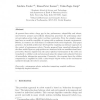Free Online Productivity Tools
i2Speak
i2Symbol
i2OCR
iTex2Img
iWeb2Print
iWeb2Shot
i2Type
iPdf2Split
iPdf2Merge
i2Bopomofo
i2Arabic
i2Style
i2Image
i2PDF
iLatex2Rtf
Sci2ools
BIOSYSTEMS
2007
2007
Robot control with biological cells
At present there exists a large gap in size, performance, adaptability and robustness between natural and artificial information processors for performing coherent perception-action tasks under real-time constraints. Even the simplest organisms have an enviable capability of coping with an unknown dynamic environment. Robots, in contrast, are still clumsy if confronted with such complexity. This paper presents a bio-hybrid architecture developed for exploring an alternate approach to the control of autonomous robots. Circuits prepared from amoeboid plasmodia of the slime mold Physarum polycephalum are interfaced with an omnidirectional hexapod robot. Sensory signals from the macro-physical environment of the robot are transduced to cellular scale and processed using the unique micro physical features of intracellular information processing. Conversely, the response form the cellular computation is amplified to yield a macroscopic output action in the environment mediated through the...
| Added | 08 Dec 2010 |
| Updated | 08 Dec 2010 |
| Type | Journal |
| Year | 2007 |
| Where | BIOSYSTEMS |
| Authors | Soichiro Tsuda, Klaus-Peter Zauner, Yukio-Pegio Gunji |
Comments (0)

